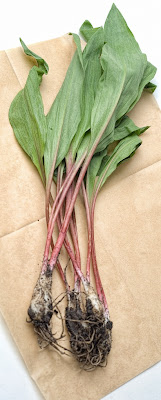As dreary February slowly slogs, I find myself "alert for the first signs of spring" much like an anxious Henry David Thoreau in his Walden cabin. Forsythia and daffodils are in full bloom in the south but the first edible green of spring has yet to emerge from its perennial bulb. Ramps, a harbinger of springtime, are feted each year with festivals,celebrations, queens, and eating contests. For a brief time they are the stars of many a spring menu.
 |
| From The Library of Congress American Folklore Collection |
Ramp season is normally late March through early April in this area (Northern Ga). Native to North America, ramps are found from South Carolina to Canada but grow especially well in Monongahela National Forest (N. Central VA). Research apprises me of this as much as my childhood memories. I spent many a spring break submerged in the Monongahela forest as a child camping, hiking, collecting and foraging. At the time I wished I was playing on the beach or at Disney like many of my friends spent their week. In retrospect, the experience of finding, gathering, and cooking my food was invaluable.
 |
| close up of ramp leaves |
Ramps are fairly easy to nose out (hee). Begin in shady areas of deciduous forests, woods, and ravines with moist soil composed of loads of organic matter, like leaves. Look for bright green, broad, flat leaves. The leaves resemble those of the Lily of the Valley, their poisonous doppleganger. A quick sniff of the leaves reveals an effluvius garlicky aroma. The ramp's bulb resembles that of a scallion but the long stem usually is purple or deep burgundy on the lower end. The leaves last a month or so then wilt and disappear. Pretty white flowers open in the middle of spring. They have a stronger flavor and make for a pretty addition to salads.
Ramps can be eaten in entirety. They are aggressively full of flavor with a taste like spring onions and the scent of garlic. They are potent in vitamins and minerals and revered for their revitalizing power. Throughout history, including Native American folklore, people have created spring tonics with ramps. The gathering of the greens is as much an ushering in of spring as it is a therapeutic awakening. After a winter with protein and starch laden foods and a lack of fresh fruit and vegetables, ramps would be incredibly revitalizing. Ramps are rich in vitamins a and c, selenium, chromium, folate, iron, antioxidants, choline and have an abundance of sulfur compounds. Thoreau was onto something when he said "we need the tonic of wildness." This ephemeral stinky plant contains compounds the prevent against cancer (Selenium), help the liver eliminate cholesterol (sulphur compounds), boost cognitive function (choline) and prevents hypertension (prostaglandin A1).
 |
| journal page |
Ramps are easy to harvest but make sure you do so ethically. There is no need to unearth an entire patch and over harvest. Besides, a little ramp goes a long way. You don't need a special tool to harvest; a screwdriver will do the trick. Brush away leaves surrounding the plant and gently dig. The bulbs grow in clumps. One way to not over harvest (besides just gathering leaves) would be to only gather part of a clump and leave the rest. You could also grow your own, but for me, part of the mystique is the thrill of the hunt. The seeds can be found on the the white flowers that grow on the leafless stalk. They are black like shotgun shot and bounce; a great seed dispersal mechanism of the plant. Seeds take 6-18 months to germinate and plants take 5-7 years to produce seeds. Enough reason to not overharvest or take baby ramps.
Ramps are great just sauteed in a bit of olive oil or mixed in with eggs or potatoes. They are incredible if you keep in mind the old addage: "foods that grow together go together." Think ramps, morels and fiddleheads. Mmmmm, the perfect combination. There is something about a dish that conveys a season with a taste; the memory of food like this stays with me. I once had a ramp custard with morel broth and buttered morels at Empire State South and I swooned. Ramp farrotto, lamb confit with ramps, and pickled ramps stand out as dishes from ESS that celebrated the ramp. Drew Van Leuvan of One Midtown Kitchen created a scallop dish with foraged mushrooms and pickled ramps last spring that was perfect. I remember it and can almost taste it. I also remember a fish Drew made with pickled ramps and mushrooms over an onion puree. Another memorable ramp special was a fish dish from The Iberian Pig. I cannot remember the type of fish (halibut, I think) but I do remember the ramps, morels, and fiddleheads along with fennel and blood orages. It was so complex, yet light; earthy yet refined. I squealed with my first bite. It tasted of spring.
Ramp Pesto
Ingredients:
2 bunches ramps,washed and trimmed
1/2 c parsley
1/2 c toasted nuts (I like pine nuts)
1/4 c Parmesan cheese, grated
1/2 t lemon juice (or a good squeeze)
olive oil
salt and pepper
1) Puree all ingredients except olive oil and salt & pepper in food processor
2) Slowly pour in olive oil to the consistency of a paste
3) season with salt and pepper then toss with pasta
*this is great on a steak as a chimchurri if you leave out the cheese.
Ramp Compound Butter
Ingredients:
1 lb butter
1-2 c ramp greens, chopped finely
2T fresh squeezed lemon juice
1) combine ingredients in food processor
2) pack ingredients into jar
3) smear on crusty bread
*keeps about 6 months in fridge and can be frozen









